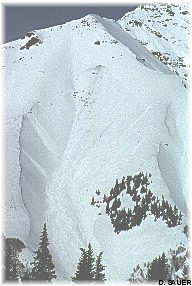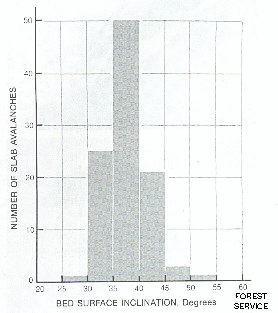This article first appeared on Colorado Firstrax, a site that began in 1995 and was run by David Sauer. The website disappeared rather abruptly without any trace. In June, 2006 a copy of much of the site as of 2001 was uncovered at web.archive.org and the avalanche section was recovered and archived here
Anatomy of a Slab Avalanche
David Sauer, originally for Firstrax
 Slab avalanches are distinguished from loose snow slides by the shape of the area that has slid, especially the upper part. The loose snow slide typically starts as a point and spreads wider as it comes down forming a V shaped scar. The falling snow is like loose powder. The slab avalanche is more like a large surface plate that comes off the mountainside and crumbles into blocks as it falls. The boundaries of this plate of snow begin as fracture lines or cracks visible on the snow surface. Unfortunately they may not be visible seconds before the slide. Slab avalanches can pack a lot more punch than loose snow slides and can bring down large areas of snow all at once. In this way they are more fearful.
Slab avalanches are distinguished from loose snow slides by the shape of the area that has slid, especially the upper part. The loose snow slide typically starts as a point and spreads wider as it comes down forming a V shaped scar. The falling snow is like loose powder. The slab avalanche is more like a large surface plate that comes off the mountainside and crumbles into blocks as it falls. The boundaries of this plate of snow begin as fracture lines or cracks visible on the snow surface. Unfortunately they may not be visible seconds before the slide. Slab avalanches can pack a lot more punch than loose snow slides and can bring down large areas of snow all at once. In this way they are more fearful.
It is not known what breaks in the snowpack first. Does the cohesion between the bottom of the slab and the bed surface below fail first? Or, do the fractures that outline the slab form first? Since it all happens in a matter of seconds it doesn't much matter to the skier who suddenly finds him/herself in a piece of the mountain that is moving.
Many times a skier may hear a deep "whumpf" type noise and even see a fracture line form above. The snow often collapses like this before a slab is released. If it does not slide consider yourself lucky and get off.
The crown fracture or fracture that forms along the top of a slab typically is longer than the flank fractures along the sides. The crown fracture can propagate surprisingly far across features of topography and can "jump" rock islands. The crown fracture is more likely to form just below a convex bulge in the topography. Whole flanks of mountains can come tumbling down from slab releases.
Slabs are roughly classified as hard slabs or soft slabs. A really hard slab is almost impenetrable by skis and poles. It could be formed by wind depositing and packing the snow. Underneath, the snow (substratum) is less dense and soft. Soft slabs may feel like great powder under your boards but below, again, is even less dense snow. All it takes is a density difference between the top layer(s) and the bottom layer(s) with the snow on top typically being twice a dense. If you add to this situation a layer in between the slab and the substratum with low cohesion that can provide the "bed surface" then the slab can slide. You may not notice the density difference between the slab and the substratum in a snow pit. You may not see the layer that it will slide on. It could be visible as graupel, TG (depth hoar), an ice crust, or surface hoar. Or, it could be none of those things. The bed surface may be just a subtle layer that provides little or no cohesion for the layers immediately above and below. Hopefully, a shovel shear test will discover such an invisible layer. Consider that the slab may slide down to the ground too!
Possible causes of slab instability are wind loading, high intensity snowfall (especially heavy, higher density snow over lighter powder) or the development of TG snow in the substratum. One factor that is not thought to be a cause is temperature changes. Warming or chilling is thought to have little effect since it affects only the surface of the snow pack. Snow conducts heat very poorly. Consider that many slab avalanches start on north slopes where temperatures fluctuate the least. Please don't mistake this to mean that warm temperatures in spring corn conditions won't start a slide. It just seems that temperature changes in the air above dry snow packs do not cause instability.

Slab avalanches, like loose snow avalanches occur most frequently on slopes between 30 - 45 degrees. So, skiing on open slopes below 30 degrees is a simple way to stay safe. Use more care when skiing above 45 degrees. The idea is that slopes over 45 degrees don't build up because they sluff off with frequent little slides that are not dangerous. But, narrow couloirs over 45 degrees can collect unstable snow if they are natural collectors of wind drift and do not sluff off regularly because they are so tight. If you wish to ski steep powder that is not prone to slide you can ski in the trees. If you drift into glades or thin trees though, watch out for those slabs.
Dave Sauer
Take the free Avalanche Center quiz on basic slab avalanche terminology!
![]() - Contributors can log in for advertising-free pages.
- Contributors can log in for advertising-free pages.



